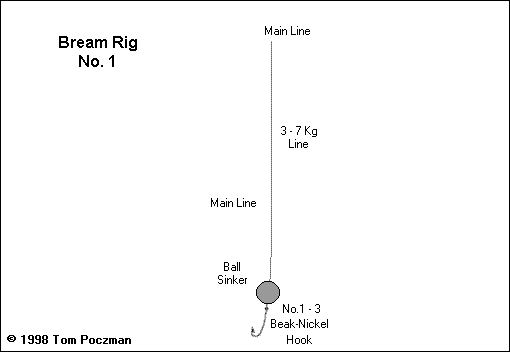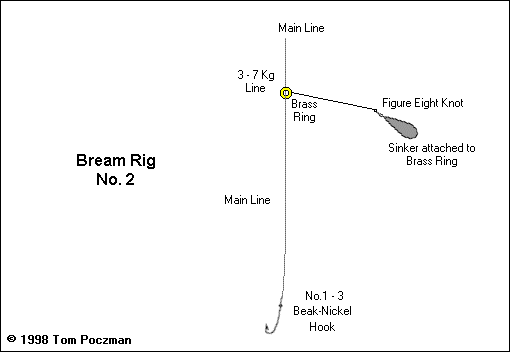Bream
Introduction
Acanthropagrus butcheri
Bream are amongst the most cautious fish in the sea. They shy away from anything which is not natural. They are extremely sensitive to noise, flashing lights and shadows. The slightest weight of the sinker on a tight line is enough for them to drop the bait. Therefore, it is essential that there is plenty of loose line so the fish can pick up the bait and not feel the line.
Before fishing, set the drag on you reel well below the breaking strain of the line, as bream will fight fiercely in the initial stages.When using worms, bait the hook fully but leave a tail of about 3 cm, and when using shrimp, slide the hook through the inside of the shrimp from the head down to the tail.
If fishing with an unattended rod (not physically holding the rod), place the rod on an angle of 45° to the water so as when the fish runs with the bait and gets to the end of the loose line, the whip of the rod is enough to sink the hook. Make sure you leave some loose line out, to let the fish run with the bait.
Bream can be found in practically all of the estuaries and seaboard rivers along the coast. They essentially live in sea water, but can survive in near fresh water.. In fact, at breeding and spawning time, the brackish waters are what they prefer. Dawn and Dusk are definitely the best times to fish for them. If there are any overhanging trees or deep holes in the river or estuary, fish near them as this is where the bream will lie during the day and feed from at night. Be sure that the bait is always fresh, and in the case of worms, live.
Bream feed together in schools at depths usually from 2 to 6m. Beach bream prefer cockles, pilchard fillets and beach worms and as mentioned earlier, bite best at dawn, or dusk, combined with a rising tide. The rising tide brings the fish out of the deeper gutters and channels and up on to sandbars in search for food.
The best months to fish for bream are during August and September, but they can be caught in lesser numbers all year round. During the winter months, bream school in deep fast running water near sand bars where rivers and estuaries enter the open sea. The best times here are at night and dawn, especially with big night tides which correspond with periods a few nights before and up to the full moon and new moon.
It's fairly important to use as light terminal tackle as you can, so as to present the bait naturally. Heavy tackle tends to present itself with the bait in an unnatural manner, there by spooking the fish.
Many years ago, I was snorkeling and spear fishing off the North Haven breakwater. Around dawn, I came across a huge school of Bream, of which, was lucky enough to spear a nice sized fish in the head. The school of Bream was a sight I will never forget.
Legal Minimum Length
| Current Limit: | 28 cm | [Previous: | 28 cm] |
Bag Limit
| Current Bag Limit: | 10 per person | [Previous: | No Restrictions] |
| Current Boat Limit: | 30 per boat | [Previous: | No Restrictions] |
There is a total closure in the Onkaparinga River, upstream of Main South Road Bridge at Noarlunga, from September 1st to November 30th, inclusive. [Previous: from November 1st to Januray 31st, inclusive].
Type of Tackle
Use line between 3 to 7kg.
A rod around 1.8m is ideal for both jetty, rock and boat fishing.
Hook Selection
No.1-3 Beak-Nickel "Holdfast" nylon snelled hooks that come pre packed are ideal.
Baits Used
Prawns, Yabbies, Shrimp, Mullet Gut, Live Tube Worms, Squid, Stripbaits of fresh fish, Small Cubes of Pilchard.
When using worms, bait the hook fully but leave a tail of about 3 cm, and when using shrimp, slide the hook through the inside of the shrimp from the head down to the tail.
Berley Mix
Bream respond well to berley in the form of prawn heads, chicken pellets, cheese, little bread, diced pilchards. Take note that you must berley only when you are ready to fish as bream tend to feed only for a short time then move on.
Rigs Used
Rig No. 1
Rig 1 can be used off the beach. It can be used in shallow water, and at times where the Bream can be extremely touchy. It allows the fish some room to move and play with the bait, before a good hookup occurs.
When cast, ensure that there is slack out of the main line, so as that if a bite occurs, your rod tip will bend, and the whip of the rod will sink the hook.

Rig No. 2
Rig 2 can be used off of rocks. The brass ring ensures that the bait can slide up and down thru the running sinker freely, giving the fish the freedom to move off with the bait. In this instance, it is the hook that is terminated at the end of the main line, not the sinker as is usually the norm. Again, make sure you leave some slack on the line, to allow the fish to run off with the bait. Use a simple half blood knot to attach your trace line to the brass ring, and a figure eight knot to attach the sinker. The sinker is shaped in that of a pearl, so that if rocks are encountered when reeling the fish in, the sinker stands a better chance of not becoming wedged within the rocks.

 Fishing Tip : Fishing Tip : |
|
| Why not contact fishSA.com about your Fishing Tip |
|
|